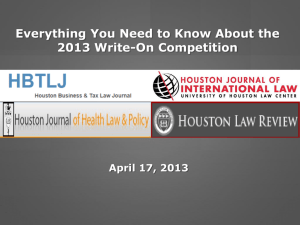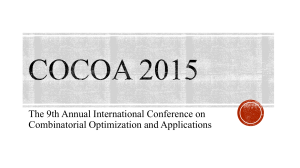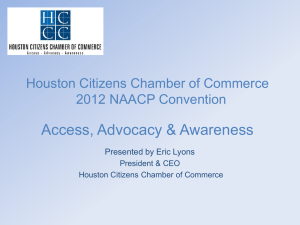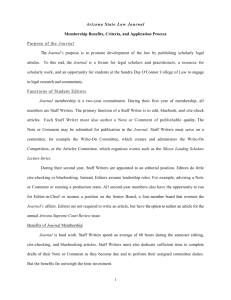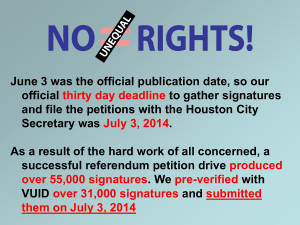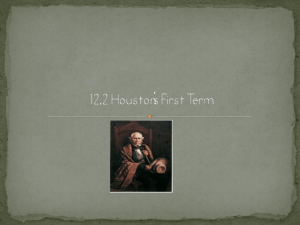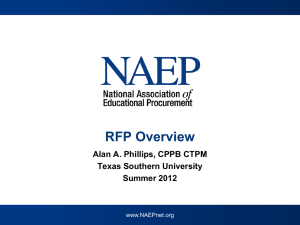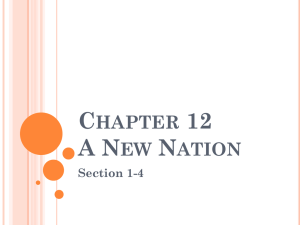2014 Write On Information Powerpoint
advertisement
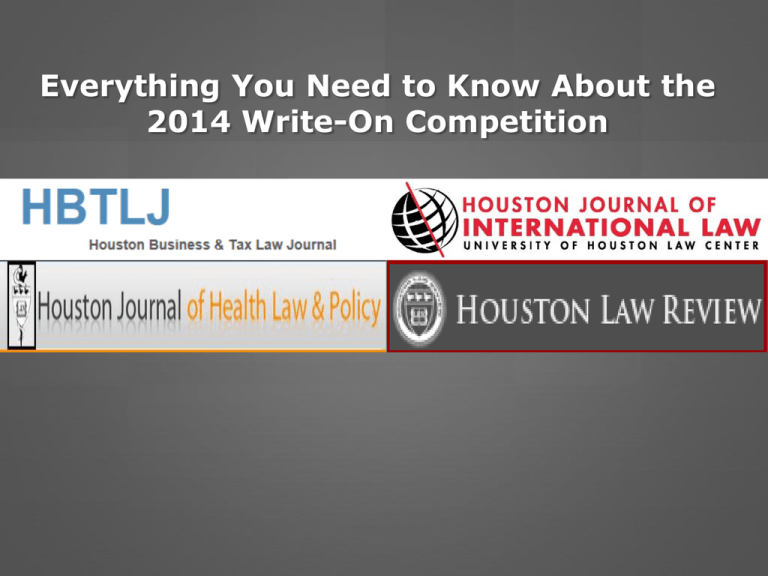
Everything You Need to Know About the 2014 Write-On Competition Who We Are Destinee Roman — Houston Law Review dkstampe@central.uh.edu Ted Seeger— Houston Law Review ebseeger@central.uh.edu Amanda Pesonen — Houston Journal of International Law adpesone@central.uh.edu Dana Lizik— Houston Journal of Health Law & Policy ddlizik@central.uh.edu Moises Morales— Houston Business & Tax Law Journal mmoral24@central.uh.edu Meeting Objectives (1) You will know the eligibility requirements to participate in the Write-On Competition. (2) You will know the “what, where, when and how” for the Write-On Competition. (3) You will leave totally calm and not overwhelmed at all (or at least have all your questions answered). What is the Write-On Competition? Law journals collaborate on an entry competition by which eligible students may gain membership. Each participant anonymously submits a 20– 30 page casenote analyzing an assigned court decision. Eligibility Eligibility requirements vary by journal. All journals require that members Have completed their first two semesters, and Have at least two full years remaining in law school Houston Law Review Destinee Roman — Houston Law Review dkstampe@central.uh.edu Ted Seeger— Houston Law Review ebseeger@central.uh.edu Grade-On: Top 10% of class or section Write-On: Top 30% of class or section Houston Business & Tax Law Journal Moises Morales (mmoral24@central.uh.edu) Grade-On: Top 20% of class or section Apply-On: Top 35% of class or section OR A or A- in at least one semester of LRW Write-On: Top 50% of class or section What if you’re interested in more than one journal? You can submit the same paper for all five journals. You must submit a separate copy of your paper for each journal you are interested in. Make sure to have all copies made and turned in to Student Services by 5:00 p.m. on July 5th! The Identification Form to be turned in with your paper contains a space for you to rank the journals you are applying for in order of preference. Competition Dates Saturday, June 7, 2014, at 8:00 am. Assigned case will be posted on the Competition Website. http://www.houstonlawreview.org/about/write-oncompetition Thursday, July 3, 2014, at 5:00 pm. Papers due to Student Services Office, with identification form. All copies must be made and the identification form filled out no later than 5:00 p.m. Late submissions will be refused! If you’re out of town, your casenote must be postmarked by this date (send to Student Services, not individual journals). Notification Friday-Saturday, July 12/13, 2014 Invitations extended to selected students. This gives you time to update your resume before OCI. Selected students must respond to the journal of their choosing by Friday, July 18, 2014, at 5:00 p.m. Anonymity Your submission is identified only by your PeopleSoft number. You will also submit an identification form with your paper, which Student Services will retain until the journals have made their selections. Do not put your name on your paper or otherwise indicate your identity! The names of selected candidates are only revealed when their papers are chosen. If your paper is not selected, your identity will never be revealed to the journals. Honor Code Rules All work must be your own. You cannot discuss research, legal theories, citation form, grammar, word choice, or any other aspect of your paper with anyone. No one can proofread your paper. It’s a violation of the honor code if this rule is not strictly followed. THE ONLY EXCEPTION: You can use the Lexis/Westlaw aides (through the website) and the UHLC Reference Librarians, for “how do I find this” questions. This does NOT mean you can’t get help before the competition starts. Questions? Getting Ready: Refer to EUGENE VOLOKH, VOLOKH’S ACADEMIC LEGAL WRITING: LAW REVIEW ARTICLES, STUDENT NOTES, SEMINAR PAPERS, AND GETTING ON LAW REVIEW (4th ed. 2010). Get a copy of the Texas Manual on Usage and Style (just Google it). Attend Professor Tabor’s Casenote Writing Workshop on Saturday, June 8th (more details to follow). Find and Read Examples of casenotes online. There are some available on the HLR website, as well as on the websites of many leading law schools. Parts of a Casenote: • • • • Introduction Case Recitation Analysis Conclusion Writing the Casenote: Read the case carefully (and each opinion). Research related case law (embedded cases are a good place to start). Start focusing your thoughts on one aspect of the case or tie in various aspects to support one unified idea. Ex: case law the court relied on, legislative history, related opinions, patterns in the law, dissenting opinions Continue researching the issue—use cases, statutes, books, and scholarly articles (Googling can’t hurt, either). Analyze and evaluate the court’s approach to the issue and the types of arguments the court is making. Consider what might happen if the rule from the case is applied to various hypotheticals. Formatting Requirements 20-30 pages. Double-spaced (text & footnotes). Times New Roman 12-point font for both text & footnotes. 1” margins (top, bottom, left, right). No tricks on word spacing, etc! ~50/50 text to footnote ratio (use Word Count to check). Every fact must have a footnote. Make sure to properly use signals and parentheticals. Tips for Writing the Best Casenote Follow all formatting requirements. Figure out your point of view, state it clearly, and argue it persuasively and efficiently throughout. Keep your legal theories simple – don’t try to overcomplicate the subject. Research as thoroughly as you can and use a variety of sources in your paper (we want to see that you can find and cite many different types of sources). Cite everything in proper Bluebook form and use parentheticals explaining your authority. Citation, citation, citation! (every time there is a fact, you have to verify that fact is true/can be inferred from another source) Strategies for Success MAKE SURE you update your access to Westlaw or Lexis for the summer! Do it now! Start early, plan accordingly Outline your thoughts early and often Organization is key Check Bluebook form Proofread 50% of your text is below the line, so that’s where 50% of your time and attention should be allocated For more detailed instruction on casenotes Attend Professor Tabor’s Casenote Writing Workshop on June 8th! A video of the presentation from 2010 is posted on the website Professor Tabor’s slides will be posted on the website A packet of useful handouts on Bluebooking and casenote formatting is available on the website. Why should I bother? It’s not as bad as it sounds! Participating on a journal has lots of benefits. The more you write, the better you get at writing (and editing, citing, etc.). Feeling Like This About the Write-On? Take a Deep Breath... It is totally doable (even if you are working and taking a class). You could grade on. You could apply on. The Journal of Consumer & Commercial Law offers students a chance to get the benefits of being on a journal without having to go through the Write-On Competition to join. Questions? Who We Are Destinee Roman — Houston Law Review dkstampe@central.uh.edu Ted Seeger— Houston Law Review ebseeger@central.uh.edu Amanda Pesonen — Houston Journal of International Law adpesone@central.uh.edu Dana Lizik— Houston Journal of Health Law & Policy ddlizik@central.uh.edu Moises Morales— Houston Business & Tax Law Journal mmoral24@central.uh.edu
